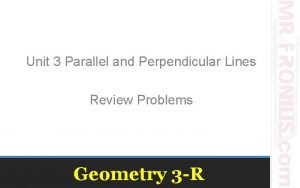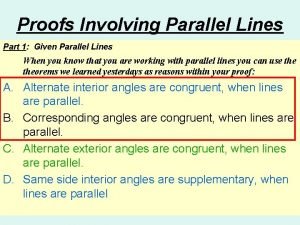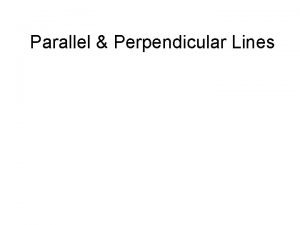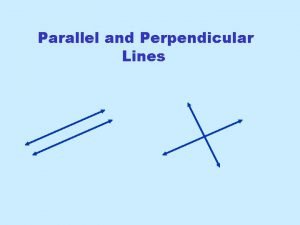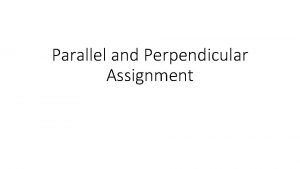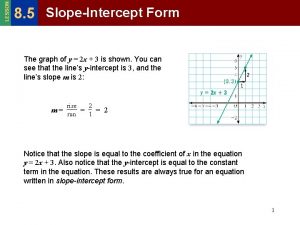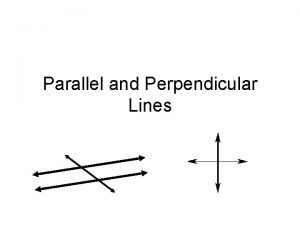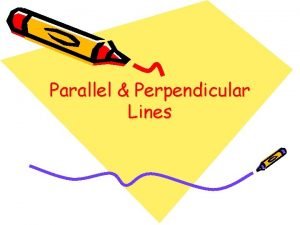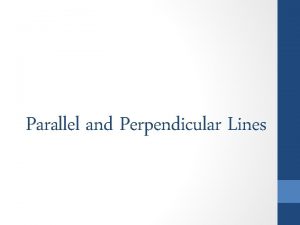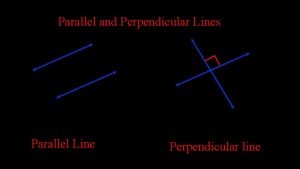Section 4 4 Parallel and Perpendicular Lines Parallel






- Slides: 6

Section 4 -4 Parallel and Perpendicular Lines Parallel lines have the same slopes (m), but different y intercepts. y = 2 x – 5 and y = 2 x + 7 are parallel lines because they both have a slope of 2 but different y intercepts. (-5 and 7). Re-write 3 x + 2 y = 8 and 4 y – 1 = -6 x + 11 into slope intercept form. 3 x + 2 y = 8 4 y – 1 = -6 x + 11 2 y = -3 x + 8 4 y = -6 x + 12 2 y/2 = -3/2 x + 8/2 4/4 y = -6/4 x + 12/4 y = -3/2 x + 3 These have the same slope of -3/2 but different y intercepts of 4 and 3, so they are parallel lines.

Perpendicular lines have slopes that are negative reciprocals of each other, like ¾ and -4/3. • Y = 5/2 x – 4 and y = -2/5 x – 4 are perpendicular because their slopes are negative reciprocals of each other. • Negative reciprocals of each other multiply to equal -1. • (5/2)(-2/5) = -10/10 = -1

• Y = -4 x + 8 and y = 1/4 x – 2 are perpendicular because their slopes are negative reciprocals of each other. • Negative reciprocals of each other multiply to equal -1. (-4)(1/4) = -4/4 = -1 Are these lines parallel, perpendicular, or neither? 2 x – 6 y = 12 and -3 x + 9 y = 18 2 x – 6 y = 12 -3 x + 9 y = 18 -2 x +3 x – 6 y = -2 x + 12 9 y = 3 x + 18 – 6/-6 y = -2/-6 x + 12/-6 9/9 y = 3/9 x + 18/9 y = 1/3 x – 2 y = 1/3 x + 2 These both have a slope of 1/3, so these lines are parallel. (They also have different y intercepts. )

Determine if these lines are parallel, perpendicular, or neither. line A line B line C line D 3 x + 5 y = 10, 5 x + 3 y = 9, 5 x – 3 y = 12, -10 x + 6 y = 6 -3 x -5 x -5 x +10 x 5 y = -3 x +10 3 y = -5 x + 9 -3 y = -5 x + 12 6 y = 10 x + 6 5/5 y = -3/5 x +10/5 3/3 y = -5/3 x + 9/3 -3/-3 y = -5/-3 x + 12/-3 6/6 y = 10/6 x + 6/6 y = -3/5 x + 2 y = -5/3 x + 3 y = 5/3 x – 4 y = 5/3 x + 1 Lines C and D are parallel with the same slope, 5/3. Line A and C are perpendicular because -3/5*5/3 = -15/15 = -1 Line A and D are perpendicular because -3/5*5/3 = -15/15 = -1

x + 4 y = 16, x - 4 y = 32, 2 x – 8 y = 16, 4 x – y = 8 Lin es Ca nd ith Da re Lines B and C are parallel ne Lines A and D are perpendicular. er. Lines A and B are neither. ne Lines A and C are neither Determine if these lines are parallel, perpendicular, or neither. line A line B line C line D Lin es ith B er an d D ar e

• Determine if these lines are parallel, perpendicular, or neither. line A line B line C line D 2 x + 3 y = 6 3 x - 2 y = 32, 2 x – 3 y = 6, 9 x – 6 y = 0 Lines B and D are parallel. Lines A and B are perpendicular. Lines A and D are perpendicular.
